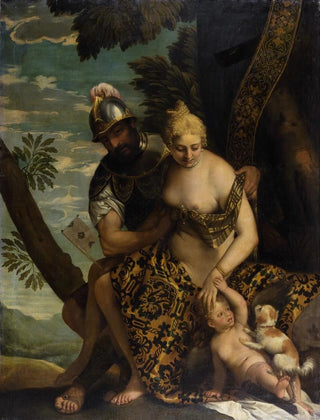Art print | Mars and Venus - Paolo Véronèse


View from behind

Frame (optional)
Mars and Venus Art print - Paolo Véronèse – Captivating Introduction
In the world of art, some works transcend time and space, captivating minds and evoking emotions. "Mars and Venus" by Paolo Véronèse is one of those creations that, through its beauty and symbolism, continues to enchant the contemporary viewer. This canvas, depicting a mythological encounter between the god of war and the goddess of love, invites an exploration of universal themes of passion, desire, and conflict. Through the richness of its colors and the finesse of its details, Véronèse manages to capture the very essence of these two iconic figures, transforming a mythological scene into a true celebration of life.
Style and uniqueness of the work
Véronèse's style is immediately recognizable, characterized by a vibrant palette and harmonious composition. In "Mars and Venus," warm tones and play of light create an atmosphere that is both intimate and grandiose. The bodies of the two protagonists are depicted with palpable sensuality, while the drapery of their clothing adds a fascinating visual dynamic. The artist also uses elements of nature, such as flowers and fruits, to symbolize fertility and love, thus reinforcing the central message of the work. The way Véronèse juxtaposes human figures with decorative elements demonstrates his skill in blending the real and the fantastical, making each glance at the canvas unique and revealing.
The artist and his influence
Paolo Véronèse, an emblematic figure of Venetian Mannerism, established himself as one of the masters of Renaissance painting. Born in 1528, he developed a style that combines grandeur and intimacy, while incorporating influences from his contemporaries. His work, often inspired by mythology and religion, stands out for its theatrical approach and meticulous attention to detail. Véronèse was able to capture the imagination of his era and influenced many artists afterward, particularly in the use of color and light. "Mars and Venus" is a perfect example of his genius, illustrating not only his technical skill

Matte finish

View from behind

Frame (optional)
Mars and Venus Art print - Paolo Véronèse – Captivating Introduction
In the world of art, some works transcend time and space, captivating minds and evoking emotions. "Mars and Venus" by Paolo Véronèse is one of those creations that, through its beauty and symbolism, continues to enchant the contemporary viewer. This canvas, depicting a mythological encounter between the god of war and the goddess of love, invites an exploration of universal themes of passion, desire, and conflict. Through the richness of its colors and the finesse of its details, Véronèse manages to capture the very essence of these two iconic figures, transforming a mythological scene into a true celebration of life.
Style and uniqueness of the work
Véronèse's style is immediately recognizable, characterized by a vibrant palette and harmonious composition. In "Mars and Venus," warm tones and play of light create an atmosphere that is both intimate and grandiose. The bodies of the two protagonists are depicted with palpable sensuality, while the drapery of their clothing adds a fascinating visual dynamic. The artist also uses elements of nature, such as flowers and fruits, to symbolize fertility and love, thus reinforcing the central message of the work. The way Véronèse juxtaposes human figures with decorative elements demonstrates his skill in blending the real and the fantastical, making each glance at the canvas unique and revealing.
The artist and his influence
Paolo Véronèse, an emblematic figure of Venetian Mannerism, established himself as one of the masters of Renaissance painting. Born in 1528, he developed a style that combines grandeur and intimacy, while incorporating influences from his contemporaries. His work, often inspired by mythology and religion, stands out for its theatrical approach and meticulous attention to detail. Véronèse was able to capture the imagination of his era and influenced many artists afterward, particularly in the use of color and light. "Mars and Venus" is a perfect example of his genius, illustrating not only his technical skill






